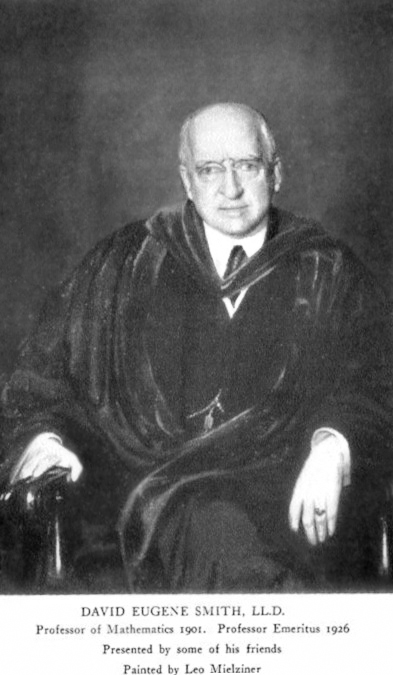Source: History of Mathematics (1925) Vol.2, p.465
Famous David Eugene Smith Quotes
Source: History of Mathematics (1925) Vol.2, Ch. 6: Algebra
p, 125
History of Mathematics (1923) Vol.1
Source: History of Mathematics (1925) Vol.2, Ch. 6: Algebra
History of Mathematics (1923) Vol.1
David Eugene Smith Quotes
This work is also noteworthy because it contains the first of an effort to represent the imaginary number graphically by the method now used. The effort stopped short of success but was an ingenious beginning.
History of Mathematics (1923) Vol.1
“The first epoch-making algebra to appear in print was the Ars Magna of Cardan”
Source: History of Mathematics (1925) Vol.2, p.384
Context: The first epoch-making algebra to appear in print was the Ars Magna of Cardan (1545). This was devoted primarily to the solution of algebraic equations. It contained the solution of the cubic and biquadratic equations, made use of complex numbers, and in general may be said to have been the first step toward modern algebra.
Source: History of Mathematics (1925) Vol.2, p. 392
Source: History of Mathematics (1925) Vol.2, p.461
Source: History of Mathematics (1925) Vol.2, p. 386, Ch. 6: Algebra,-->
Source: History of Mathematics (1925) Vol.2, pp.461-464
Source: History of Mathematics (1925) Vol.2, p.464
Source: History of Mathematics (1923) Vol.1, p. 90
Source: History of Mathematics (1925) Vol.2, p.464
Source: History of Mathematics (1925) Vol.2, p.430
History of Mathematics (1925) Vol.2
1819
Source: History of Mathematics (1925) Vol.2, Ch. 6: Algebra
History of Mathematics (1923) Vol.1
History of Mathematics (1925) Vol.2
David Eugene Smith, "Editor's Introduction," in: The Teaching of Elementary Mathematics https://books.google.com/books?id=NKoAAAAAMAAJ (1906)
Source: History of Mathematics (1925) Vol.2, p.469
1745
Source: History of Mathematics (1925) Vol.2, p.469
Source: History of Mathematics (1925) Vol.2, Ch. 6: Algebra
of Deventer
Source: History of Mathematics (1925) Vol.2, pp.467-468
Source: History of Mathematics (1925) Vol.2, p.449
Source: History of Mathematics (1925) Vol.2, p. 384; Ch. 6: Algebra
Source: History of Mathematics (1925) Vol.2, Ch. 6: Algebra, p. 378
David Eugene Smith, History of Modern Mathematics https://books.google.com/books?id=EwcCAAAAYAAJ, 1896; 1904
History of Mathematics (1923) Vol.1
Source: History of Mathematics (1925) Vol.2, p. 430; footnote
History of Mathematics (1923) Vol.1
History of Mathematics (1923) Vol.1
